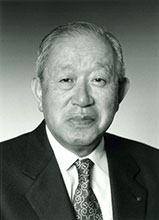ALERT!
This site is not optimized for Internet Explorer 8 (or older).
Please upgrade to a newer version of Internet Explorer or use an alternate browser such as Chrome or Firefox.
Tribute to Juro Wada, MD
 Dr. Juro Wada passed away on February 14, 2011 at his home in Tokyo, Japan. He was 88 years old.
Dr. Juro Wada passed away on February 14, 2011 at his home in Tokyo, Japan. He was 88 years old.
Dr. Wada was a pioneer in cardiothoracic surgery in Japan and was well-known among American and European surgeons by the nickname of “Jelly Wada”. Dr. Wada was also a confident and energetic teacher and mentor. With his short haircut and short operating gown, he resembled the famous TV brain surgeon Ben Casey. Unlike conventional Japanese professors, Dr. Wada gave American-style lectures to medical students in English, and inspired many medical students to pursue careers in surgery. Eleven of my 60 classmates eventually entered Dr. Wada’s Department of Surgery Sapporo Medical University in 1968.
Dr. Wada was born on March 11, 1922 in Sapporo, Japan, the son of Sadasumi Wada, a professor at the University of Hokkaido. Dr. Wada received his medical degree from the University of Hokkaido in 1944 and obtained PhD degree on the thesis of Frostbite related to hypothermia at the 2nd Department of Surgery, University of Hokkaido. After earning his PhD, Dr. Wada worked at Yakumo-Naji Hospital in Hokkaido until 1949.
As the first Japanese student to study overseas after World War II, Dr. Wada moved to the United States to further his clinical training. In those days, the journey to the US was arduous; it took him two weeks by ship from Yokohama to San Francisco, and then another week by Greyhound bus from San Francisco to Minneapolis. In 1950, Dr. Wada started work as a fellow (Gariowa Fellowship) alongside Drs. Dennis, Cross, Lillhei, and Shumway at the Department of Surgery at the University of Minnesota, where Professor Wangesteen was chairman. In 1952, as chief resident, Dr. Wada worked at the Department of Thoracic Surgery at Ohio State University, and in 1953, as a fellow, he worked at Brigham Hospital and Harvard University in Boston under Dr. Harken
In 1954, when his father fell seriously ill, Dr. Wada returned to Japan. As he was requested by President Dr. Ohno, he established a new Department of Cardiovascular Surgery at Sapporo Medical University and was promoted to Professor of Surgery in April 1958. He married his wife Shuko in September 1958.
To list just a few of his achievements, he performed the first ascending aortic aneurysm repair in Japan in 1959; he performed the first funnel chest repair in 1960 and invented the sternal turnover technique for funnel chest; he performed the first total arch replacement in Japan in 1965; he made hyperbaric chamber for mine explosion casualties in 1966. He invented the Wada-Cutter Valve Prosthesis in 1968 an original tilting disc valve with central flow that influenced the Bjork-Shiley valve and Lilleihei-Kaster valve. The Wada-Cutter valve is widely used in both mitral and aortic positions in our department. The valve was employed in a total artificial heart made by Dr. Liotta and was implanted in a human by Dr. Cooley. He also performed the first successful Mustard operation in Japan.
On August 7, 1968 Dr. Wada also performed the first heart transplant in Japan—only the 30th such operation worldwide—and although the patient’s condition eventually deteriorated, the patient survived 83 days after operation.
In 1977, Dr. Wada became Chairman of Surgery at Tokyo Women’s Medical University. After moving to Tokyo, he traveled around the world to meet with cardiac surgeons in other countries, as well as to attend meetings and give lectures.
After retiring in 1987, Dr. Wada established the Wada Heart and Lung Institute in Tokyo. In 2007, in Athens, Greece he was chosen as one of the top seven preeminent cardiac surgeons in the world, alongside Drs. Cooley, Starr, Ross, Carpentier, Yacoub, etc. He also celebrated Golden Jubilee of marriage with his wife and his friends in same year.
Dr. Wada is survived by his wife, Shuko, and their daughter, Mariko.
Teruhisa Kazui, MD, PhD
Cardiovascula Center
Hokkaido Ohno Hospital
Sapporo, Japan




